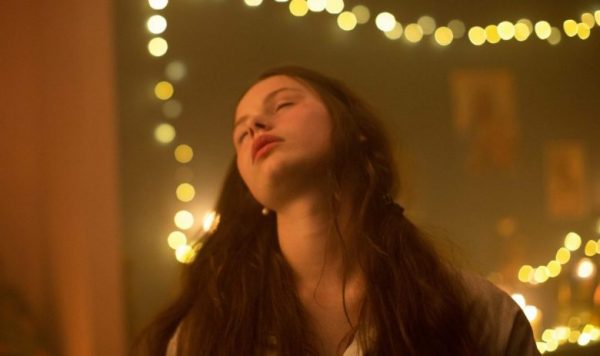Film Review: “Zombi Child” — Alluring Haitian-French Folk Horror
By Peg Aloi
At times, Zombi Child successfully hovers between spooky documentary and an art house coming-of-age film.
Zombi Child, directed by Bertrand Bonello. At the Museum of Fine Arts Boston, through March 1.

Louise Labèque in a scene from Zombi Child.
Zombi Child (shown during the Quinzaine des Réalisateurs at the Cannes film festival) opens with a scene set in Haiti in 1962. It comes off as both a lush lyrical vignette and a slice of cinema-verité ethnography. In close-up, someone cuts up a puffer fish, placing the chunks, along with other ingredients, into a mortar and pestle. We see a man collapse in the street. His body is sent off to burial via a somber yet raucous funerary procession (complete with a Haitian-inflected version of “Auld Lang Syne”). The body is disinterred and the man is forced into slavery on a sugar plantation. There are others working the cane fields, who have the same affect as this man (slow, shuffling, confused), who we learn is Clairvius Narcisse (played by Markenson Bijou), whose story is also the basis for Wes Craven’s The Serpent and the Rainbow.
We then fast-forward to contemporary Paris, to a classroom at a girls’ boarding school where a history lecture is in progress. The French Revolution, the energetic male teacher tells us and them, is the iconic symbol of human freedom. But because the film begins in what was once a wealthy French colony embroiled in upheaval, the thesis takes on ironic historical and cultural resonances. It’s tempting to suspect at this early moment that filmmaker Bertrand Bonello (Saint Laurent, Nocturama) is crafting a “zombie as metaphor for imperialism” story, but it turns out that there is much more going on in this unusual film.
In the classroom we see the beautiful, pale face of Fanny (Louise Labèque). She is daydreaming about her long-distance boyfriend Pablo, to whom she is composing a love letter while she listens absently to the lecture. We also see Mélissa (Wislanda Louimat), a Haitian immigrant (and the only black girl in the class), who relocated to Paris to live with her aunt after her parents died in the 2010 earthquake. Fanny is part of an elite group of girls who have created a secret literary society. She befriends Mélissa after the two discuss books in between classes and convinces the other girls to let Mélissa join them. The others are reticent, suggesting that Mélissa is odd, but when she recites the poem Cap’tain Zombi by Rene Depestre, a poem that critiques the white consumption of black culture, she is welcomed into their fold.
These scenes of the girls’ club are intriguing, with candlelight meetings and singing and hushed whispers, more coven than clique. When Mélissa reveals that her aunt is a voodoo priestess, the girls are enticed further. Mélissa is aware of her weird, intimidating allure and plays upon it, telling Fanny that one day “I’m gonna eat you.” But Fanny, distracted by fantasies of Pablo, whom she envisions in erotic yet innocent scenarios, decides to use Mélissa’s voodoo connections for her own narcissistic purposes. It doesn’t go well. This is not exactly a horror film (although there are frightening moments); the concerns here are more anthropological than supernatural. But they are no less fascinating, and perhaps more chilling, because of their documentary authenticity.
The narrative switches between the present day of Fanny, Mélissa, and the others in Paris with existence on the plantation in Haiti 60 years before. Rather than hammering home the point that French imperialism led to the harsh economic and social conditions plaguing Haiti, Bonello weaves a rich tapestry of influences and impressions, encouraging viewers to weigh these complex relationships for themselves. At times, Zombi Child successfully hovers between spooky documentary and an art house coming-of-age film, a testament to how well contrasting moods and aesthetics are balanced. Photographed by Yves Cape (Holy Motors) and with a compelling, evocative score composed by Bonello himself, there are haunting moments here that leave indelible impressions.
The film’s concern with duality reflects what W. E. B. Du Bois called double consciousness, and the idea that a person of color’s racial identity is always viewed through a lens of white racism. Complicating this psychological vision is the fractured nature of Haitian culture itself, the overripe fruits of the vestiges of colonialism. There’s a romantic quality to the visuals that pop up at seemingly incongruous times, as in the voodoo scenes, or the shots of the girls playing field sports. The glimpses of Haiti’s natural splendor and horrific poverty are made to look like pages in a vintage color travelogue, while the girls’ nighttime meetings feel like a ’70s occult thriller. For all of its anthropological power, Zombi Child presents an absorbing kaleidoscopic landscape of imagery that beguiles and confounds; at times we don’t know where we are, or even if we’re awake or dreaming.
Peg Aloi is a former film critic for the Boston Phoenix and member of the Boston Society of Film Critics. She taught film studies in Boston for over a decade. She writes on film, TV, and culture for web publications like Vice, Polygon, Bustle, Mic, Orlando Weekly, Crooked Marquee, and Bloody Disgusting. Her blog “The Witching Hour” can be found at themediawitch.com.

Fabulous review. I was curious beforehand, now I’m off to to see it !